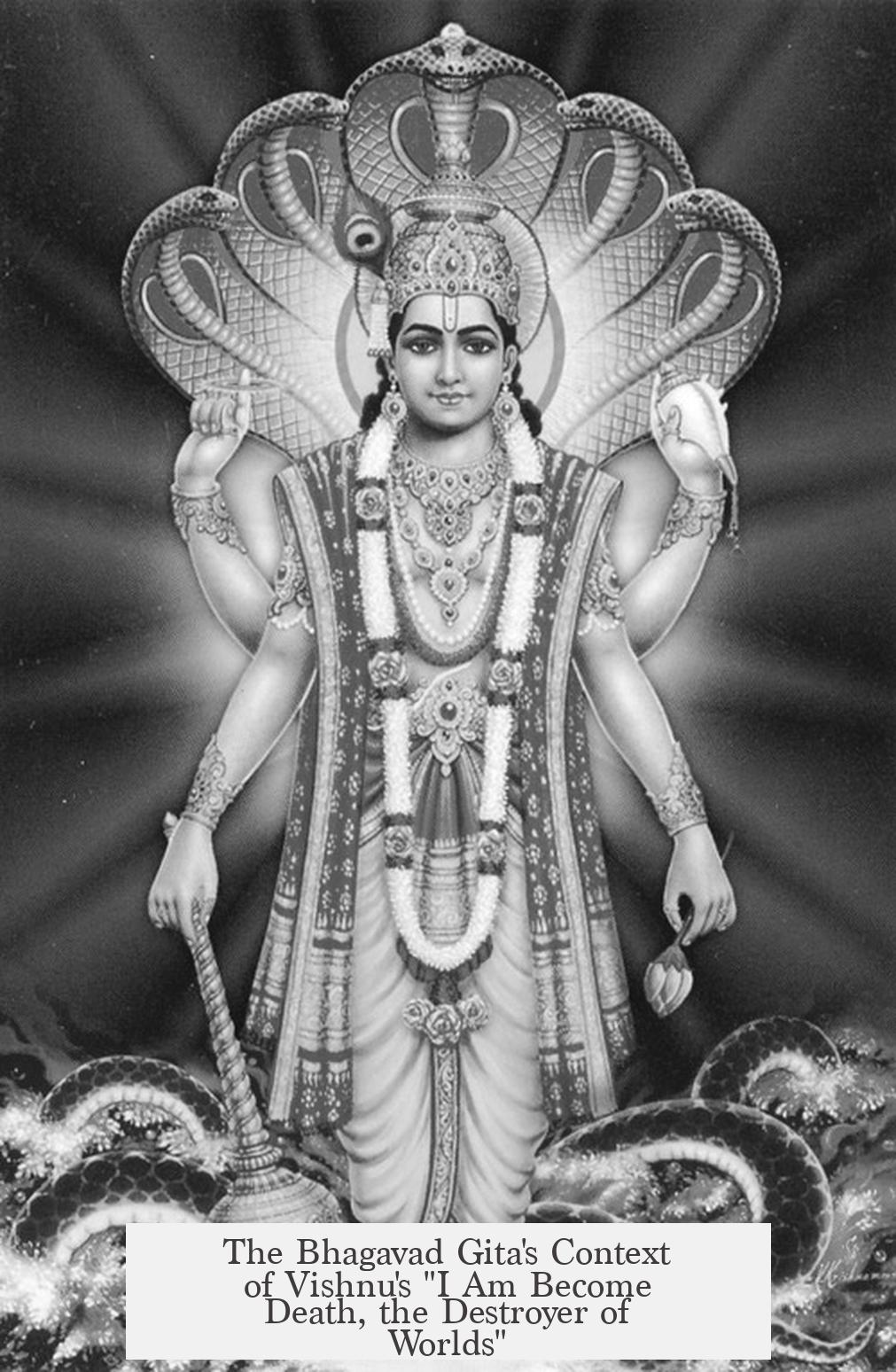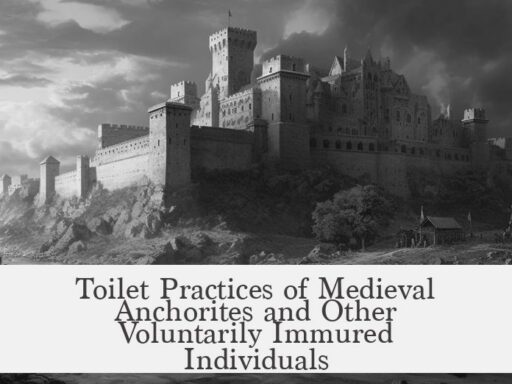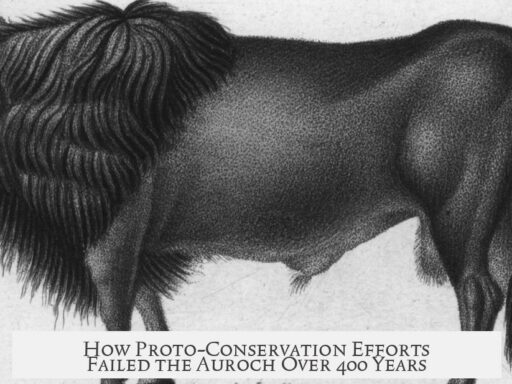The phrase “Now I am become death, the destroyer of worlds” originates from a critical moment in the Bhagavad Gita, a sacred Hindu scripture embedded within the Mahabharata epic. This statement is from Lord Krishna, an avatar of Vishnu, revealing his divine cosmic form to Prince Arjuna during a pivotal battle. Krishna utters this line to express his role as the ultimate force of destruction and transformation in the universe.
The Bhagavad Gita is a concise spiritual dialogue nested inside the vast Mahabharata, one of the longest epics in world literature. The scene unfolds on the battlefield of Kurukshetra, just before a great war between two factions of the same royal family, the Pandavas and the Kauravas. Arjuna, the main warrior for the Pandavas, faces an emotional crisis. He hesitates to fight against his kin and teachers, fearing the moral consequences of killing relatives and friends.
As Arjuna wrestles with doubt and sorrow, his charioteer Krishna, who is also the god Vishnu incarnate, counsels him on duty, righteousness, and the nature of life and death. Krishna urges Arjuna to fulfill his duty as a warrior—a dharma (moral obligation)—without attachment to the results. He explains that life and death are transient and that the soul is eternal and unchanging.
Despite Krishna’s teachings, Arjuna remains uncertain. To demonstrate his supreme universal form, Krishna reveals his divine cosmic shape known as the “Vishvarupa.” This terrifying vision shows Krishna as infinite, multi-armed, blazing with flames, and encompassing all creation and destruction.
When Krishna unveils this form, he declares his identity as “Death” and the “Destroyer of Worlds.” This statement highlights Krishna’s role not just as a protector but also as an agent of destruction, necessary for the renewal and balance of existence. The vision is meant to embolden Arjuna to perform his duty, understanding that destruction is part of cosmic order and not mere chaos.
In modern times, this phrase gained international recognition through J. Robert Oppenheimer, lead scientist of the Manhattan Project during World War II. Upon witnessing the first detonation of an atomic bomb, Oppenheimer recalled this line from the Bhagavad Gita. He saw a parallel between Krishna’s revelation and the destructive power unleashed by the bomb. For Oppenheimer, the atomic bomb embodied the divine destructive force, while he identified with Arjuna, a reluctant participant in a larger cosmic event.
Oppenheimer’s translation is somewhat personal and incorporated concepts taught to him by his Sanskrit teacher, Arthur Ryder. This version rendered the passage as “Now I am become death, the destroyer of worlds,” a poetic and powerful way of capturing Krishna’s declaration during his cosmic revelation. The original Sanskrit text uses complex symbolism, making exact translation difficult, allowing for varied interpretations.
| Key Points | Explanation |
|---|---|
| Mahabharata Context | The Bhagavad Gita is a philosophical dialogue within the Mahabharata focusing on duty during war. |
| Arjuna’s Doubt | Arjuna hesitates to fight his own relatives, questioning the morality of war. |
| Krishna as Vishnu | Krishna, as the god Vishnu, advises about dharma and reveals his cosmic form. |
| “Destroyer of Worlds” Quote | Krishna proclaims his role as death and destruction during the vision, symbolizing cosmic balance. |
| Oppenheimer’s Use | Oppenheimer quoted this verse after the atomic bomb test, equating the bomb to a force of destruction like Krishna. |
This profound passage serves as a meditation on the inevitability of destruction and creation in life. Krishna’s words express the cosmic principle that some duties—no matter how difficult—must be fulfilled to uphold order (dharma). The destroyer is not malevolent but necessary to clear the way for new beginnings.
Hindu scholars and practitioners interpret this passage differently. Some view it literally as a divine truth, others as metaphorical for the cycle of birth and death, or a lesson in detachment from the fruits of actions. The phrase has gained wider cultural resonance due to its association with the atomic age and the moral questions surrounding human-made destruction.
- The Bhagavad Gita is a conversation between Krishna and warrior Arjuna during a critical battle.
- Krishna reveals his cosmic “destroyer” form to encourage Arjuna to fulfill his duty.
- “Now I am become death, the destroyer of worlds” highlights Krishna’s role in cosmic destruction necessary for renewal.
- Oppenheimer famously quoted this line after the atomic bomb test, identifying with Arjuna’s conflicted position.
- Interpretations vary, but the phrase symbolizes duty, destruction, and the cycle of life in Hindu philosophy.
A Backstory on the Bhagavad Gita and Vishnu’s “Now I am become Death, the destroyer of worlds”
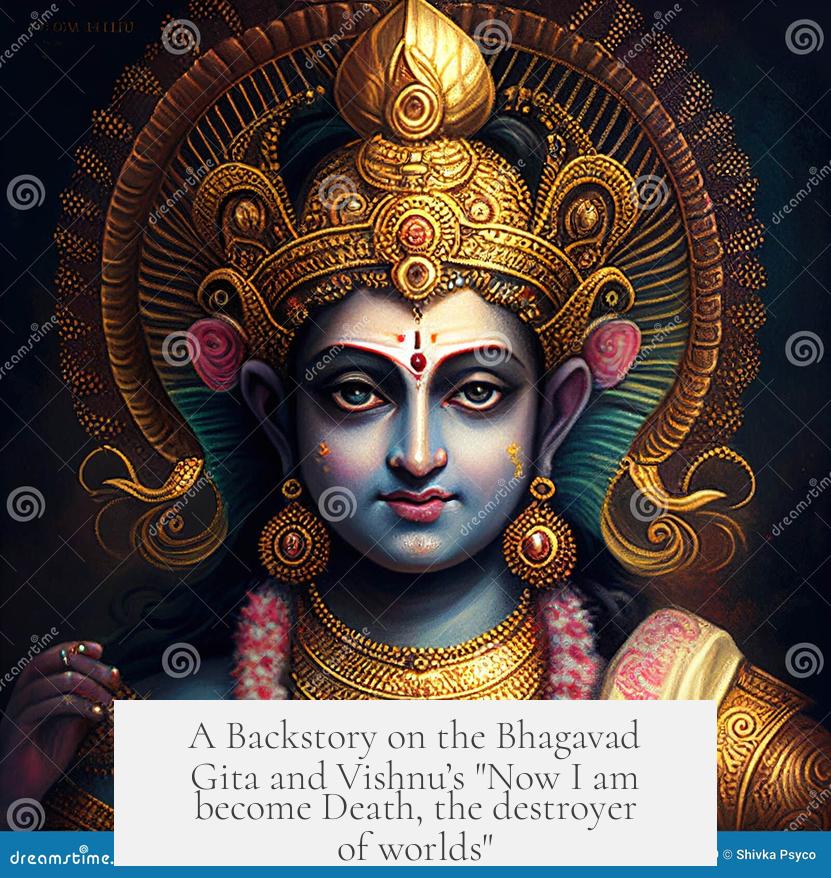
If you’re asking for a backstory on when Vishnu (in his avatar as Krishna) said, “Now I am become Death, the destroyer of worlds,” here it is, in a nutshell: This famous line comes from the Bhagavad Gita, an ancient and profound spiritual scripture. The words capture a moment when Krishna reveals his cosmic, terrifying form. But before jumping into that, let’s unpack the saga behind it.
The Bhagavad Gita isn’t a standalone text; it’s part of the colossal Indian epic called the Mahabharata. Picture the Mahabharata like an epic blockbuster series with every possible plot twist, flawed heroes, morally grey villains, divine interventions, and endless drama. The Gita is a brief, intense scene within this larger story—ran by Krishna, who is Vishnu’s avatar (or earthly incarnation).
The Mahabharata: Not Your Usual Good vs. Evil Tale
Unlike your typical epic where “goodies” and “baddies” are crystal clear, the Mahabharata flips the script. The characters blur moral lines.
- Duryodhana, the so-called “villain,” is smart and a just ruler in his own eyes.
- Karna, his loyal companion, is possibly the purest character but ultimately falls because of his unwavering loyalty to Duryodhana.
- Krishna, the hero and avatar of Vishnu, isn’t a saint either – he cheats, lies, and can get fiery.
- Yudhishthira, the “most noble” Pandava, is a strict upholder of truth but famously loses everything in a gambling game.
You see what I mean? It’s a chaotic human drama with gods involved, not a clear-cut morality play.
The Prelude to the Gita: Battle Lines Drawn
The core conflict is this: The five Pandava brothers are rightful heirs to a kingdom. However, the 100 Kaurava brothers (led by Duryodhana) cheat them out of it. After years of ups and downs, including living in exile, the Pandavas claim their kingdom back.
Duryodhana, of course, refuses to give it up, backed by the entire royal court. Armies muster on both sides. The battlefield is Kurukshetra, and it’s massive. Imagine millions of soldiers, war elephants, chariots, all ready for a brutal showdown.
Arjuna’s Crisis: The Scene of the Gita
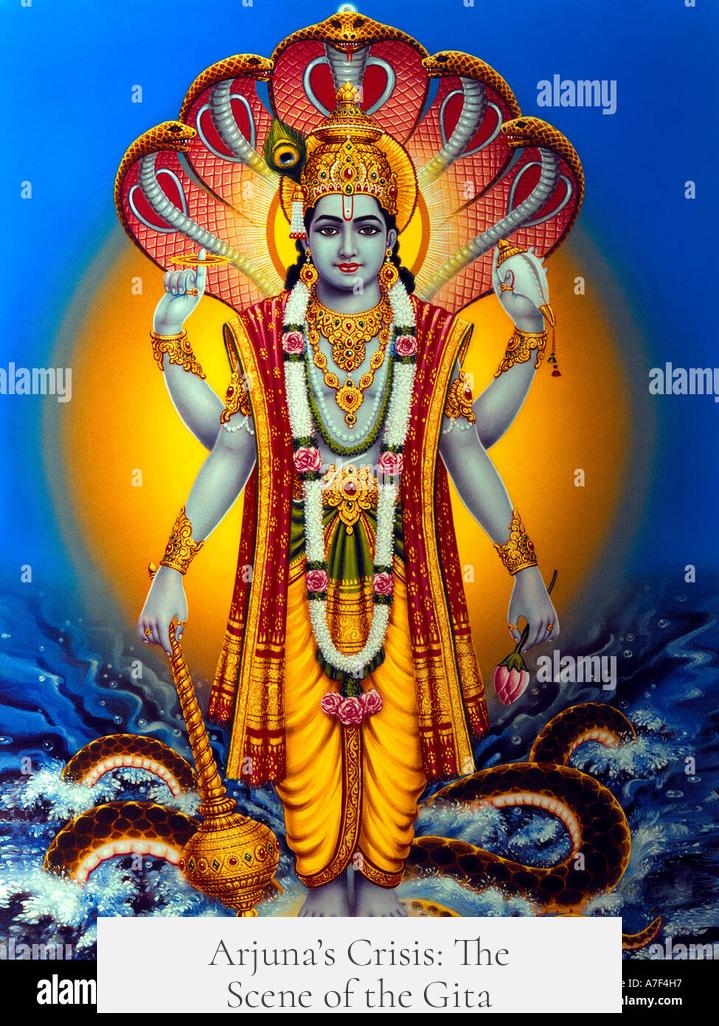
The moment the Bhagavad Gita hones in on is a dramatic pause just before the fighting begins. Arjuna, the best warrior on the Pandava side, is struck with doubt. He looks across the battlefield and sees family, teachers, and friends aligned opposite him. He’s overwhelmed.
So, what does he do? He throws down his bow and arrow, says, “I can’t do this,” and surrenders to his charioteer, Krishna, for guidance.
It’s here that Krishna launches into the iconic sermon—the Gita—talking about Dharma (duty), Karma (actions and their consequences), and the illusionary nature of the world (Maya). He explains that not fulfilling one’s duty is Adharma (impiety or disorder). In Arjuna’s case, his duty as a warrior means fighting, even if it means killing relatives.
Krishna’s Divine Revelation
When Arjuna remains unsure, Krishna reveals his divine, cosmic form. This is the moment of “Now I am become Death, the destroyer of worlds.” It’s Krishna’s way of showing that he’s beyond human—his true form encompasses creation and destruction, beyond good and evil.
This vision shakes Arjuna to his core. The gigantic, terrifying godly form Krishna reveals symbolizes the unyielding cosmic law of destruction, necessary for rebirth and change.
How J. Robert Oppenheimer Came Into the Picture
Fast forward to the 20th century. J. Robert Oppenheimer, the “father of the atomic bomb,” famously quoted this line after witnessing the first nuclear test.
But here’s a twist: Oppenheimer was not quoting directly from the Bhagavad Gita in Sanskrit. His phrasing and translation came from Arthur Ryder, his Sanskrit teacher. Ryder’s version was personal and idiosyncratic.
And more importantly, in Oppenheimer’s narrative, he places himself as Arjuna, the hesitant prince who struggles but must face an inevitable and terrible duty. The atomic bomb is Krishna—the awful power unleashed on the world.
Oppenheimer’s story is one of reluctant acceptance. He’s the man caught in a cosmic battle of physics and ethics. He doesn’t become the “destroyer of worlds” himself; he watches, understands, and accepts the monumental power in his hands.
Why This Moment Resounds Across Cultures and Time
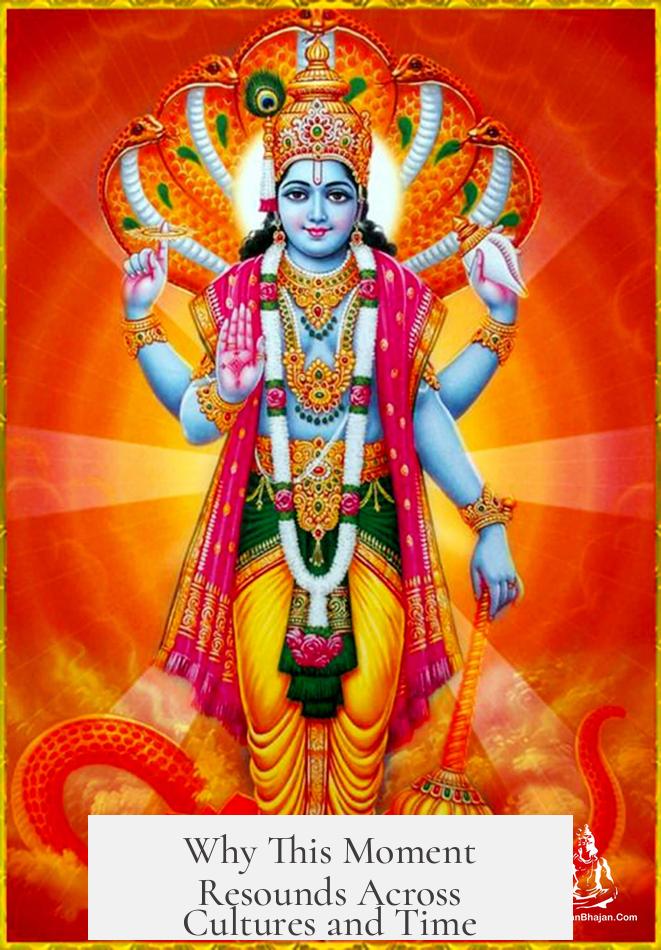
This phrase and the scene represent a universal theme: the terrible power of destruction tied to creation. It’s not just about war or death. It’s about inevitability, duty, and the cosmic cycle.
The Bhagavad Gita, through Krishna’s revelation, tells us that the universe operates on laws much bigger than our personal feelings or even morality as we understand it.
Destruction is part of creation. It’s harsh but necessary. And sometimes, duty demands we act despite personal hesitation or moral uncertainty.
What Can We Learn from Krishna’s “Destroyer of Worlds” Moment?
- Duty Over Emotion: Arjuna’s hesitation is human, but Krishna teaches that fulfilling one’s role in life is crucial—sometimes harsh but necessary.
- Moral Ambiguity Exists: The Mahabharata and Gita avoid simple good vs. evil tropes. People, even gods, have flaws. Understanding this complexity helps us navigate real-world dilemmas.
- Destruction Is Part of Renewal: The cosmic form showing destruction is not just violence for violence’s sake but part of a larger cycle of renewal.
- Awareness of Cosmic Forces: Oppenheimer’s analogy reminds us powerful forces often overwhelm the individual, who must come to terms with their role in vast, uncontrollable events.
Practical Tips for Engaging with the Bhagavad Gita and this Passage
- Don’t Rush: The Gita’s message is deep. Take time to understand its context within the Mahabharata’s sprawling tale.
- Focus on Duty: Reflect on your personal duties and responsibilities. How do you handle moral conflicts?
- Learn Moral Complexity: Avoid black-and-white thinking. Embrace complexity when judging actions and characters.
- Consider Different Interpretations: Scholars and devotees vary widely in their readings. Compare versions and explore modern commentaries.
Wrapping Up
“Now I am become Death, the destroyer of worlds” is far more than a chilling quote. It’s a dramatic moment in the Bhagavad Gita that encapsulates deep philosophical insights about duty, destruction, and the human role in the cosmic order. The line’s fame also owes much to its 20th-century reincarnation through Oppenheimer, who found a parallel between ancient philosophy and modern atomic reality.
So next time you hear that line, remember: it’s not just about death or war. It’s about how we face our duties, the ugly truths of moral complexity, and the universal cycles that govern existence.
Have you ever faced a moment where duty clashed with personal beliefs? How did you resolve it? The Bhagavad Gita might just have some answers wrapped in divine wisdom and poetic cosmic grandeur.

